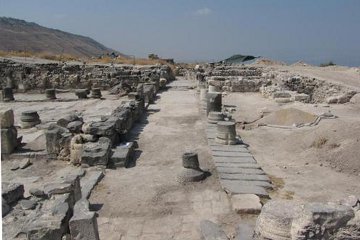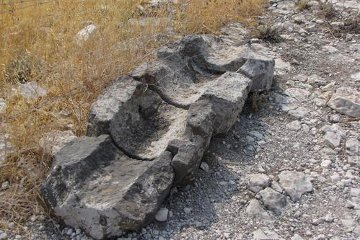An Excavation Too Far

| |
| Sussita on a hazy day, from a boat out on the the lake. |
One of the highlights of our tour of Israel is a cruise on or across the Lake of Galilee. Frequently this finishes up at the kibbutz of Ein Gev on the eastern shore where we wait for half an hour before the return journey. There is not all that much to do at the kibbutz unless you are fascinated by the idea of communal living and wish to explore in detail the arrangements for dining, childcare and working, so I find myself staring up at a flat-topped hill on the skyline high above Ein Gev.
Flat-topped hills are not a natural feature, so I was not at all surprised to learn that this particular one is the ancient city of Sussita, one of the ten Greek cities that made up the Decapolis. It was founded in 200 BC by the Antiochid rulers of Syria when they took Palestine from the control of the Egyptian Ptolemies and, naturally, its original name was Antiochia Hippos.
Despite its proximity to the kibbutz, however, Sussita has not received much attention from the archaeology-loving Israelis. This is mainly because until 1967 it was under the control of the Syrians, whose gun positions overlooked Ein Gev. I suppose they just got used to thinking of it as unreachable, because it is only in the last ten years that excavations have commenced on Sussita, conducted by a team from Poland. In the last two years they have been joined by a group from Concordia University in Minnesota.
Like many another group before them, the Poles have the ambition of uncovering the entire city, street by street. In their case this is possibly achievable because there are unlikely to be stratum upon stratum. The city was built in the Greek period and was, so far as we know, never destroyed by enemy action or natural disaster.

| |
| Some of the excavated buildings of Sussita. Like most places in Galilee, black basalt was the main building stone. |
That is not to say that there will not be complications, however. Already the excavations have uncovered two Christian churches (out of the five known to have existed there) and discovered that one of them was built over the remains of an early third century AD temple of the Imperial cult. Which one, we wonder, will the excavators fully uncover and restore?
In any case, we deplore the attempt to uncover a site in its entirety. There are two reasons: the first is that a covering of earth preserves and as soon as that covering is removed, deterioration sets in, both from the weather and also from human activity. Sussita has survived 2,000 years under the soil: how long will it last above ground? The answer, we suspect, is "Not very long". It is only the most popular sites that can support and extensive and continuing programme of restoration and repair.
The second is that the science of archaeology is constantly developing. When the Americans attempted the same thing at Megiddo they worked to the highest standards of their day, but today we can only mourn the destruction of the knowledge that we could have extracted from the same site. To take just one example, not a single grain of pollen was identified by the University of Chicago: today pollen identification is an important tool in the archaeological armoury.

| |
| Roman stone water pipes, broken in half. Possibly they were fractured by water pressure! |
For this reason, no matter how attractive the thought of walking down the main street of Antiocha Hippos may be, it would be far better if the archaeologists were to content themselves with opening up a square or a trench, discovering what they can and leaving the rest for later generations to explore using the techniques of the future.
Nonetheless, I hope that we will be able to visit Sussita next time we visit Israel. So far the Poles have uncovered a quarter of a mile of colonnaded main street, a rectangular forum and a large basilica paved with multi-coloured mosaic dating from about AD 580. Last season they cleared the sacristy area and discovered two reliquaries - though the martyrs whose relics they contain cannot now be identified. They have also explored the area of the diakonikon, the part of the church where offerings in kind were stored to be used either by the priests and monks associated with the church or distributed to the poor. Here they have found bronze and iron tools and containers and a wonderful Ummayyed decanter.
The Americans, working in the other church, have discovered two burials in front of the apse, one of which was a sarcophagus containing the body of a 60 year old woman. Clearly these people must have been important in the town, probably because of their social position, but it is not impossible that they were the founders of the church.





